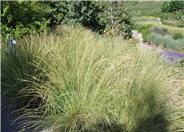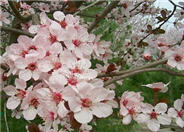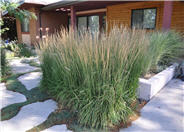
Common name:Switch Grass
Botanical name:Panicum virgatum
Switch grass is a north American native and an original component of the Midwestern Plains. It is a warm-season (it goes dormant during the winter) clumping grass with an upright form, interesting flowers, showy fall color, and a great winter presence. It grows from 4 to 7 feet tall and about half as wide, though in time may spread wider. Airy, delicate flowers appear in mid-summer, hanging along an arching, wiry stem, and are pink to red to orange. Foliage turns yellow to orange in the fall, and the flowers turn a silvery white. there are now many cultivars to choice from, and they all make excellent and low-care additions to perennial or shrub borders, or in more naturally styled settings.

Common name:Krauter Vesuvius Purple-leaf Plum
Botanical name:Prunus cerasifera 'Krauter Vesuvius'
'Krauter Vesuvius' is a deciduous, small tree with a dense, twiggy, oval crown, growing to about 20 feet tall and 15 feet wide. It has light pink, fragrant flowers that emerge before the leaves. Leaves emerge a deep red and mature to a reddish purple; it retains this reddish color best in full sun. Small, red, edible fruit ripen July and August. Autumn leaf color is golden yellow to orange. Naturally low branching, and so place where that isn't an issue.

Common name:Karl Foerster Feather Reed Grass
Botanical name:Calamagrostis acutiflora 'Karl Foerster'
Karl Foerster feather reed grass is a garden favorite, and for good reason. Its green, fine-textured foliage is gently arching and grows to about 2 feet tall and wide. Oat-like plumes stand very erect over the foliage, growing as tall as 5 to 6 feet. Plumes open whiteish green, later turning a dusky rose, and then tawny colored by winter. Blooms early summer with the plumes lasting into autumn. Holds its presence well into winter. Excellent in mixed perennial or shrub borders, or massed.
| Designer: Glen Trope | Modern Style 2 |
Photographer: GardenSoft |
Water Saving Tip:
Replace turf with groundcovers, trees, and shrubs. If you have areas where no one uses the grass, patches that do not grow well, or a turf area too small to water without runoff, consider replacing the turf with water-efficient landscaping.
